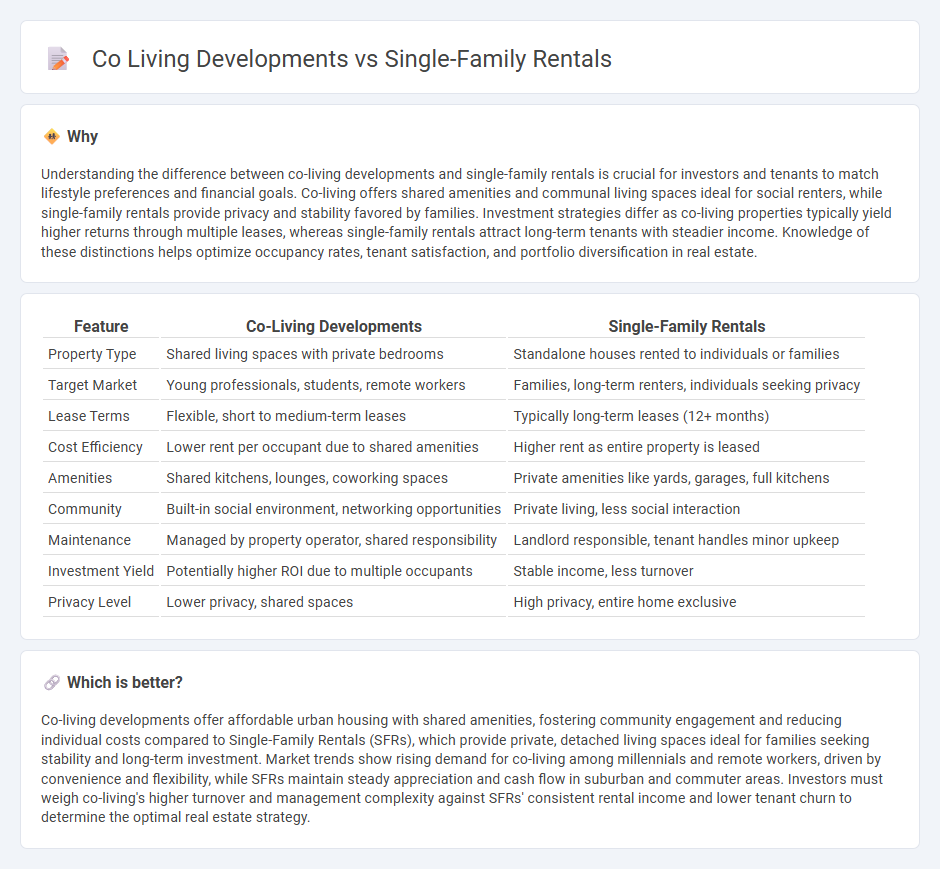
Co-living developments offer communal living spaces designed for shared amenities and flexibility, attracting young professionals and remote workers seeking affordable urban housing. Single-family rentals provide private, standalone homes ideal for families desiring more space and long-term stability in suburban neighborhoods. Explore the benefits and challenges of each housing option to determine the best fit for your lifestyle and investment goals.
Why it is important
Understanding the difference between co-living developments and single-family rentals is crucial for investors and tenants to match lifestyle preferences and financial goals. Co-living offers shared amenities and communal living spaces ideal for social renters, while single-family rentals provide privacy and stability favored by families. Investment strategies differ as co-living properties typically yield higher returns through multiple leases, whereas single-family rentals attract long-term tenants with steadier income. Knowledge of these distinctions helps optimize occupancy rates, tenant satisfaction, and portfolio diversification in real estate.
Comparison Table
| Feature | Co-Living Developments | Single-Family Rentals |
|---|---|---|
| Property Type | Shared living spaces with private bedrooms | Standalone houses rented to individuals or families |
| Target Market | Young professionals, students, remote workers | Families, long-term renters, individuals seeking privacy |
| Lease Terms | Flexible, short to medium-term leases | Typically long-term leases (12+ months) |
| Cost Efficiency | Lower rent per occupant due to shared amenities | Higher rent as entire property is leased |
| Amenities | Shared kitchens, lounges, coworking spaces | Private amenities like yards, garages, full kitchens |
| Community | Built-in social environment, networking opportunities | Private living, less social interaction |
| Maintenance | Managed by property operator, shared responsibility | Landlord responsible, tenant handles minor upkeep |
| Investment Yield | Potentially higher ROI due to multiple occupants | Stable income, less turnover |
| Privacy Level | Lower privacy, shared spaces | High privacy, entire home exclusive |
Which is better?
Co-living developments offer affordable urban housing with shared amenities, fostering community engagement and reducing individual costs compared to Single-Family Rentals (SFRs), which provide private, detached living spaces ideal for families seeking stability and long-term investment. Market trends show rising demand for co-living among millennials and remote workers, driven by convenience and flexibility, while SFRs maintain steady appreciation and cash flow in suburban and commuter areas. Investors must weigh co-living's higher turnover and management complexity against SFRs' consistent rental income and lower tenant churn to determine the optimal real estate strategy.
Connection
Co-living developments and single-family rentals address the growing demand for flexible housing options driven by urbanization and changing lifestyle preferences. Both models emphasize community-oriented living with shared amenities and affordable rents, appealing to millennials and remote workers. Data shows that co-living spaces often serve as a gateway to single-family rentals, promoting long-term residential stability within evolving real estate markets.
Key Terms
Lease Structure
Single-family rentals typically feature long-term leases lasting 12 months or more, providing tenants with stability and predictability in housing costs, while co-living developments often use shorter, flexible lease agreements ranging from month-to-month to six months, catering to transient renters and young professionals. The lease structure in co-living arrangements commonly includes communal utilities and shared services bundled into a single payment, contrasting with single-family rentals where tenants handle utilities separately. Explore further to understand how lease structures impact tenant experience and landlord management strategies in these housing models.
Tenant Demographics
Single-family rentals predominantly attract families and long-term tenants seeking privacy and stability, with average occupants typically ranging from three to four individuals. Co-living developments appeal primarily to young professionals, students, and transient workers who value affordability, community, and flexible lease terms. Explore more about how tenant demographics influence the dynamics of these housing models.
Property Management
Property management in single-family rentals involves individualized tenant relations and maintenance, ensuring personalized service and property upkeep. In co-living developments, property managers handle shared amenities, community engagement, and conflict resolution among multiple tenants simultaneously. Explore further to understand how these management strategies impact investment returns and resident satisfaction.
Source and External Links
Houses for Rent in Fresno CA - Discover 148 single-family homes for rent in Fresno, CA, with features like private pools and attached garages.
Houses For Rent in Fresno County CA - Zillow offers 500 single-family rental listings in Fresno County, CA, allowing detailed filtering for the perfect place.
Houses For Rent in Fresno, CA - Explore 316 single-family homes for rent in Fresno, California, with options to filter by neighborhoods and local guides.
 dowidth.com
dowidth.com